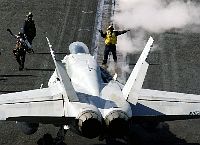
The Source for Navy News
Successful Joint Task Force Exercise for Stennis Carrier Strike Group
Story Number: NNS040408-18
Release Date: 4/8/2004 9:08:00 PM
![]()
By Boatswain's Mate 1st Class Tina Martinez, Commander, U.S. 3rd Fleet Public Affairs
ABOARD USS JOHN C. STENNIS (NNS) -- Joint Task Force Exercise (JTFEX) 04-1 off the Southern California coast has drawn to a close, and Rear Adm. Patrick Walsh, commander, Carrier Group 7 said he's very pleased at the incredible way the entire strike group worked together.
JTFEX, which officially ended April 7, was the last major preparation before the Stennis Carrier Strike Group deploys in May.
During JTFEX, the strike group’s skills were put to the test. Over the past several days, the carrier and its accompanying ships and aircraft dealt with scenarios involving air strikes and support missions, anti-submarine warfare and Maritime Interdiction Operations (MIO). Each event measured the strike group’s logistics support, search and rescue techniques, and command and control ability. Every obstacle was intended to push the strike group to the limit, and to challenge each and every crew member.
Walsh said he uses two key elements to gauge the strike group’s success: confidence and persistence.
“I’m looking for confidence in the crew, the aviators, and operators at sea,” he said. “I want technicians to stay focused and to be able to accomplish a variety of missions under difficult conditions.”
Walsh said he defines persistence as “the ability to keep going, even when you’re discouraged, when there’s opposition, even when you’ve failed previously.” He feels persistence is a skill that cannot be found in a book or a class, but “has to be experienced.”
While JTFEX is a procedural practice, it is also an opportunity to test the limits of the crew. Evaluators tested the crew's persistence by seeing how long they could go before they had to take a break during the exercise. The troops put in 12-hour days, attended briefings and debriefings, went to bed and then got up the next day to do the same thing all over again.
Stennis Commanding Officer Capt. David Buss said his crew once again met the challenge. “There are more than 5,000 people aboard, and they were able to focus around a single mission, and made sure that every day, they contributed their part.”
Buss said the biggest challenge during a JTFEX is to bring people from all different backgrounds together, and to learn team-building quickly and effectively. He said the Navy put the crew under high-stress situations, and they did an excellent job carrying out the mission.
“This [JTFEX] is a graduation of sorts,” said Buss. “And being certified ready to deploy is really icing on the cake.”
The pilots involved in the exercise use JTFEX training for the maximum effect possible, and not just to sharpen their arrested landing skills.
According to Deputy Chief of Staff Capt. John McCandlish, the live-fire exercises allowed the pilots to hone their bombing skills, as well. McCandlish also praised the young enlisted men and women who kept the flight deck up and running all hours of the day and night.
Buss said his distinguished visitors remarked that while the flight operations were impressive, they thought the junior Sailors who kept everything in motion were the real story.
Nearly 9,000 officers and enlisted personnel aboard 11 ships and submarines participated in JTFEX. There are 60 to 70 planes aboard Stennis, including S-3B Vikings, EA-6B Prowlers, F/A-18C Hornets and F/A-18E Super Hornets, F-14 Tomcats, and H-60 Seahawks.
For related news, visit the Commander, U.S. 3rd Fleet Navy NewsStand page at www.news.navy.mil/local/c3f.
E-mail this story to a friend | Send a comment about this story
|
All Any Exact |
|
